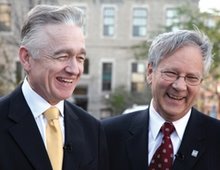"First dismissal of a tenured university professor in Canada, over an academic matter."

The second day of binding labour law arbitration hearings into the University of Ottawa wrongful dismissal case of physics professor Denis Rancourt before Arbitrator Claude Foisy was held on October 12, 2011.
In addition to four lawyers/advisers on each side, the griever and the Arbitrator, there were approximately twenty student and academic supporters and representatives from the media and civil society present.
Two preliminary motions were argued, following written submissions from both sides (HERE-Oct.3rd and HERE-Oct.7th).
Despite the five-month period between the first day of arbitration (DAY-1: May 2, 2011) and the second day of arbitration (DAY-2: October 12th) and despite the Arbitrator's instructions to provide the submissions early to allow his early decisions on all preliminary matters before DAY-2, the University did not provide its written motion submissions until October 3rd.
This was followed by the Union (APUO) reply submissions on October 7th.
Following the posting of two Youtube videos about DAY-1 (VIDEO-1, VIDEO-2), the University has:
- dropped its request for a media ban (its so-called "enriched exclusion"),
- abandoned using the griever's so-called "post-dismissal behaviour" (code for "UofOWatch blogging") to bar media access, and
- stopped pondering legal advances to prevent its written submissions from being public.
The Union responded (Oct.7th submissions) that student and alternative media video cameras should be allowed, that Rancourt needed full access to all discovery/disclosure documents, and that Rancourt's UofOWath blog was part of his academic freedom.
This was all followed by a surprise weekend call from the Arbitrator, presumably after viewing the Youtube videos, telling the two sides that he was not in favour a priori of video cameras but that he would hear submissions from the public and media on video access.
The first matter at the actual DAY-2 hearing was the question of barring griever Rancourt from free access to discovery documents. On this question, it is not an exaggeration to say that the University, represented by lawyer Lynn Harnden, bombed. Their argument for barring the griever from free access to the evidence was technical and tenuous.
Lawyer for the Union Sean McGee put a document shredder on the desk in front of him, plugged it in, took the university submissions and shredded them, then walked over and poured the shreddings on Lynn Harnden's desk, to the amazement of all present, figuratively.
At this point, the University asked for a short recess, walked out, and came back to say with a brave face that they no longer had concerns about the griever's free access to the evidence against him.
Next was the question of video access to the hearing.
Oral submission were heard (all off camera) from the griever and from several members of the media, a government scientist, academics, and civil society (accredited NGO Canadians for Accountability). Further written submissions were invited until October 18th, to be sent to both Harnden and McGee.
The Arbitrator took detailed hand-written notes of all the oral submissions and promised to answer all submission points in his final public decision on video access.
It is expected that the Arbitrator will have ruled on all outstanding preliminary matters before DAY-3 which is scheduled for October 31st.
The place of the DAY-3 hearing is to be announced. The Arbitrator expressed his desire to accommodate the student complaints about physical access to the hearings by requesting that a venue be found which is more accessible from campus.
DAY-3 (October 31st) should see the opening arguments of the University, giving their statements as to why they fired Rancourt.
Hearings schedule and background links are HERE.




No comments:
Post a Comment